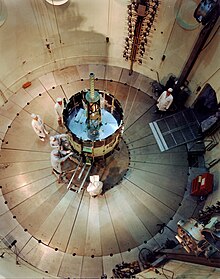Explorer program


The Explorer program is the first and most extensive satellite and space probe program in the United States .
history
1957 decided the Soviet Union with the Sputnik 1 , the race for the first artificial satellite in space for themselves. It had officially started with the announcement of the US President on July 28, 1955, to put an artificial satellite into orbit as part of the International Geophysical Year . The Soviet Union had officially declared the same intention a few days later.
At the time of the Sputnik launch, the USA were actually not yet ready to take off with their Vanguard project, and at the end of 1957 they tried an early launch in response to this so-called Sputnik shock . The launch ended in a disaster, however: the launch vehicle, which had never been fully tested, exploded on the launch pad in front of millions of television viewers.
This gave the Explorer series the chance to launch the first satellites into orbit and was extremely successful over the Vanguard project. On February 1, 1958 , Explorer 1 was the first American satellite to be successfully launched into orbit. Under the name Explorer, more than 82 successful missions have been carried out in a wide variety of research fields, from exploring the ionosphere and radio astronomy to atmospheric and earth exploration . These satellites, developed mainly by the army in Huntsville (Alabama) , with the help of the experienced group around the former technical director Wernher von Braun of the former Army Research Institute in Peenemünde , were thus the first US satellites in orbit - and thus an important first step towards manned spaceflight .
Missions
Each Explorer satellite (since Explorer 6) has a sub-name - depending on which scientific project it was part of.
Since the early 1990s, subroutines have been started in the Explorer program:
- SMEX ( Small Explorer ) for small research missions since the early 1990s.
- MIDEX ( Middle-Sized Explorer ) for medium-sized research satellites from the late 1990s.
- STEDI ( Student Explorer Demonstration Initiative ) and UNEX ( University Explorer ) for small university missions for NASA.
A complete listing of the 102 Explorer satellites launched so far can be found in the list of Explorer missions .
source
- Nasa Facts: Explorers: Searching the Universe Forty Years Later
Web links
- NASA: Explorer History (English)
- NASA: Explorer-I and Jupiter-C (English)
- Bernd Leitenberger: Explorer in moon orbit
- NSSDC: The Explorer missions in the National Space Science Data Center (English)

